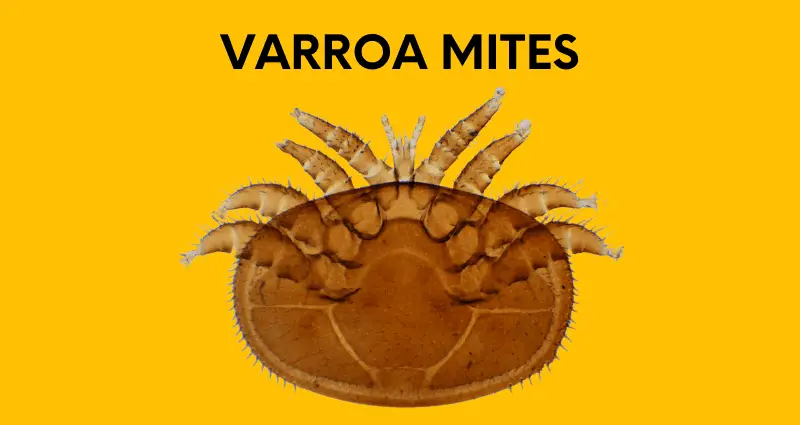Varroa mites are the primary cause of honeybee colony loss. New beekeepers need to be aware of this threat and how to control varroa mites before deciding to start their first colony.
What Are Varroa Mites?
Varroa mites, also known as Varroa destructors, are tiny ectoparasites that feed on the fat body tissue of adult worker bees and their larvae and pupae while still in their brood cells.
Native to Asia and the Asian honey bee (Apis cerana), varroa mites spread to European honey bees (Apis mellifera) in the mid-1970s and have since spread worldwide, with the exception of Australia. These mites are considered one of the leading causes of bee colony collapse disorder (CCD).
Adult female mites enter honey bee brood cells before capping and laying eggs on and around the bee larvae. The female mates with a male mite, and the male dies shortly thereafter. Only the female mites feed on bees, and the females can live up to two months. However, depending on the climate, they can sometimes overwinter between an adult honey bee’s sclerites (hard plates between its exoskeleton).
Why are varroa mites so devastating to honey bees?
- Varroa mites are capable of rapidly infesting hives. During the summer season, they reproduce quickly and can multiply into hundreds within days or weeks.
- Varroa mites can survive under unfavorable environmental conditions or over long distances due to their ability to attach themselves to clothing, vehicles, or migratory birds.
- Varroa mites spread bee viruses and infections among honey bees, which can lead to erratic flight patterns due to damage to their wings and legs.
What Do Varroa Mites Look Like?
Varroa mites are small, oval-shaped parasites that measure around one millimeter in length and vary in color from light tan to black.
They are easily recognizable by their unique shape and protruding hairs along the body margins. Under magnification, you can see what appear to be hooks or claws at each end of the flat body, which aid in grabbing onto bee hosts for feeding purposes.
Varroa Management &Treatment
The presence of varroa mites can be identified through a visual examination of adult bees or infested larval cells and testing or monitoring methods such as regular sugar shakes or alcohol washes.
If an infestation is suspected, action must be taken quickly. Treatments involving mechanical removal methods, such as screen bottom boards, or chemical treatments, such as formic acid, may be used depending on where your apiary is geographically located.
The earliest signs of a varroa mite presence include:
- Slowed brood production
- Reduced adult bee size
- Weakened wings and deformed wing virus (DWV)
As soon as the infestation is identified in your hive, you should begin a varroa mite treatment program as soon as possible. You can use several methods to treat these pests, including:
Chemical treatments
Various types of pesticides can be used to eradicate mites while keeping bee populations intact. Common chemicals used in varroa treatments include oxalic acid, formic acid, coumaphos, flumethrin, tau-fluvalinate, and amitraz. When using chemical treatments on colonies with weak or moderate infestations, carefully follow the instructions provided on the labels.
Drone trapping
Trapping drones within the hive may help capture adult varroa mites that climb onto them during mating flights away from the hive. Once trapped, the drone and its associated parasites can be disposed of properly – preferably away from other hives or bees!
Screened-bottom boards
Adding screened-bottom boards with sticky boards can help you monitor your beehive for pests and catch varroa mites that fall through. They’re also helpful if you choose to use a natural treatment method, like ‘sugar shaking,’ to encourage the bee’s grooming behavior. Dusting the bees with powdered sugar will encourage them to groom each other. The attached mites and the grooming sugar will fall through the screened-bottom boards, making cleanup much easier and naturally controlling mite levels.
Foundationless frames
This is more of a proactive measure, but bee colonies that build natural honeycombs in foundationless frames tend to build smaller honey and bee brood cells. This is important because varroa mites use brood cells to reproduce. With larger cells (like the ones on foundation frames), incubation time is longer — giving mites more time to reproduce.
Heat treatments
Selective pressure heating techniques can also be used to drive out varroa mite populations from a colony without harming bees or their brood production capacity. However, heat should not be overused as it can harm beneficial microorganism populations inside honeybee hives if applied too liberally and frequently.
Varroa sensitive hygiene (VSH) bees
The United States Department of Agriculture (USDA) bred varroa-sensitive hygiene ‘cleaning bees’ that are able to detect and remove bee pupae from infested brood cells. These cleaning bees significantly slow mite reproduction and reduce mite levels.
Essential oils
For beekeepers looking for natural treatment and prevention strategies, several essential oils have been evaluated and deemed effective against mites and safe for honey bees. It’s important to note that thymol, one of the most popular oils for varroa, is only effective against adult mites; it does not penetrate capped brood cells to kill mite larvae.
Regardless of your chosen method, it’s important to remember that an integrated pest management (IPM) plan that multiple techniques will often provide better protection against varroa destructors.
When To Treat For Varroa Mites
The most effective time to treat colonies for varroa is typical during late summer or early autumn when honey flow tends to slow.
Another window of opportunity occurs at the end of winter or early spring when honey production starts again, and hives become less concentrated.
Depending on environmental conditions in your area, hives may need treatment during both periods to provide optimal protection from varroa invasion.
Note that certain factors like climate can impact recommended treatment times for varroa mites, so it’s best to check with experienced local beekeepers.
Frequently Asked Questions
What is a varroa mite?
Varroa mites are parasitic mites that feed on honey bees and reproduce in brood cells. They are a significant cause of the decline in bee populations.
What are the signs of a varroa mite infestation?
Signs of a varroa mite infestation include an increase in the number of dead bees in the hive, small patches of dead or deformed wings on the bees, and an increase in the number of mites on the bottom board of the hive.
How can I protect my bees from varroa mites?
There are several methods for controlling varroa mites, including using screened bottom boards and using chemical treatments such as oxalic acid or formic acid.


